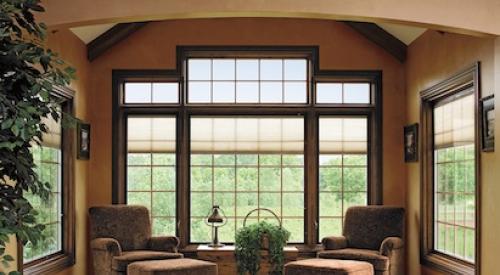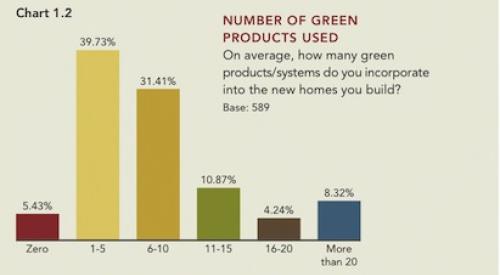|
Whoever said charity begins at home was one-upped last October 3 when millions of Americans watched crews from Shea Homes donate thousands of dollars in time, resources and labor to build a new house for the Garay family of Los Angeles on ABC's Extreme Makeover: Home Edition.
When HomeAid America and ABC offered Shea CEO Bert Selva the opportunity, he says he "couldn't say no" to helping this needy family of 11. While the favorable public relations didn't hurt, Shea earned a much more fundamental benefit in giving its employees the chance to make a difference.
Shea, along with other builders on this year's list of 50 Best Companies To Work For, provide similar charitable acts to their communities and their own employees as well, from affordable homes to housing discounts, design center upgrades and appliances. These and other, more conventional corporate discounts that motivate employees as they feed the bottom line, are only part of what makes for a winning workplace.
What makes a company a good employer — or prospective employer? This year's data from sister company Reed Research Group defy easy trend spotting because there's no finite recipe for success. Taken as a whole, however, these 50 companies tend to possess a strong and consistent sense of their own identity; a strong business plan; a realistic view of the organizational training and resources needed to execute on plan; and the ability to walk the talk of their own public marketing messages.
Large companies with sophisticated training and leadership development programs win points with employees, but size isn't everything. While Pulte Homes took the top spot in this year's first-ever ranked "Best Companies" report and five of the top 10 companies are listed on Professional Builder's GIANTS 400 list, little Gulfstream Homes took third place, and many small companies throughout the rankings flank additional industry GIANTS like D.R. Horton (22) and KB Home (41).
Across the 50 Best Companies To Work For, the employee base includes the following:
- 39% are female
- 15% are minorities
- 19% are younger than 35
- 11% are older than 55
- Employed at their current company for 3.9 years (on average,)
None of these factors played a major role in placing a company in the rankings, although the seven companies with 50% or more employees under 35 years tended to be smaller (130 employees or less) and had fewer employees aged 55 and older than the overall group. Likewise, no trend emerged in starting salaries, turnover rates, percentage of health benefits covered or vacation time. This, if anything, reinforces the notion that the best employers share more similarities than differences in what they offer employees:
- 96% sponsor a 401(k) plan
- 88% offer profit sharing throughout the organization
- 82% offer tuition reimbursement
- 76% pay quarterly bonuses
- 72% provide flexible schedules
Stock options (22%), telecommuting (22%) and job sharing (14%) tend to skew toward the top of the rankings, indicating possible areas of employee preference for flexibility in job structure. More than any small group of statistics, though, it seems that the best companies are those that offer benefits in a much more complete package.
A survey by the Society for Human Resource Management (SHRM) and the Wall Street Journal's CareerJournal.com found last year that employee loyalty and faith in executives' trustworthiness are interrelated. It behooves companies to foster that trust with accurate, open communication on company developments. While well-run small businesses may seem to have an edge in promoting familial trust, the big guns can win by putting people first, too.
Pulte, for instance, takes its "people development" philosophy seriously. Founder and chairman Bill Pulte has said on more than one occasion, "One of the most easily copied things in our business is our houses. The thing they can't copy is our people and our culture." Following the boss' lead, Pulte CEO Richard Dugas attends leadership development classes with budding managers and holds town-hall meetings in every division each year. His policy is to invest in employees in advance of need, and the strategy has paid off with a job satisfaction score rivaled only by high scores in customer satisfaction.
Small companies, too, can think big. Grayson Homes (32), which closed 134 homes in 2003, has spent several years implementing a total quality management program, retooling its business processes and training courses. The strategic program corresponded with hard day-to-day work that yielded significant increases in revenues and customer referrals and a reduction in construction costs.
The hard work of refining the company's operating procedures and culture yielded another important development: 100% of employees surveyed said they would recommend the company as a good place to work. Grayson Homes' attention to quality assurance earned the company recognition in the National Housing Quality Award program for quality management three years in a row, as well as recognition in this survey of the best employers.
It didn't hurt Grayson Homes to link bonuses to customer satisfaction as well as other goals. Companies with high job satisfaction don't just dole-out bonuses and other perks on subjective whims, they use them as "play hard" rewards for hard work done well.
Wayne Homes (36), for instance, follows strict hiring, training and motivational principles, but also designates two employees as "vice presidents of fun" who organize stress-relieving parties and events.
Charter Homes (39) also blends incentives with a bit of fun, using "Rob Bucks" — play money named for company president Rob Bowman — that are redeemable for logo merchandise. Additionally sales-and-satisfaction programs have awarded bonuses as large as 20% of an employee's salary, and performance-based bonus trips have included expenses-paid trips to the Bahamas.
Not to be outdone, David Weekly Homes (11), a regular on both Fortune's and Professional Builder's "Best Companies" lists, gave every full-time employee (and guest) a one-week, expenses-paid trip to Maui. This was a deserved reward for the group's digging deep to hit five-year goals that helped the company double sales and ratchet customer satisfaction to 95%.
Employers that nurture their people are more likely to weather the vicissitudes of a job market growing increasingly competitive. In the fall of 2004, as the economy began to rebound, most employees SHRM surveyed said they were actively or passively seeking a new job; 48 percent said they were actively searching.
The study noted various retention tools to combat "voluntary turnover," the most popular being competitive merit increases, promotion of qualified employees and career development opportunities, and concluded: "While monetary compensation is a strong retention tool, both employees and HR professionals indicated that efforts to develop, challenge and promote employees within the organization can significantly increase retention."
The "Best Companies" in this Professional Builder report would seem to agree. Results, weighted mostly by employee surveys (See Methodology sidebar), show that most companies stress training, leadership and professional development programs. The modes vary but include a mix of in-house classroom instruction, computer-based training, on-the-job training and mentoring; and outside programs from college reimbursement to business and industry participation.
Pulte is a leader in hiring and training college graduates for months before letting them loose in the field, and also gives each employee, new or old, an average of 172 training hours annually. While the company's programs are more formal than those of 14-employee Tripp Trademark Homes (21), led by Doug Tripp (a former Pulte division head), it is the quality, not the quantity of programs that brings job satisfaction to companies of all sizes.
While large companies have a budget advantage in seeking top talent using well-oiled campus recruiting programs, their smaller counterparts can use their relative agility, flexibility and sheer reputation. Mid-sized companies with good reputations, for instance, make great career bait for experienced big-company managers seeking to make a splash as bigger proverbial fish in smaller ponds. In other cases, some companies do well with well-targeted recruitment ads, online job boards, local job fairs and a trickle of summer interns. Employee referral bonuses are now common, and so are outside recruiters when the need is acute.
Recently, William Ryan Homes (17) closed its Cincinnati division and opened a new one in Tampa, Fla., and was able to fill some new positions — the division president, sales superintendents and at least one sales person — through relocation. An outside recruiter helped fill the rest. One source at the company estimates that 75% of new hires are from the industry, though this is not an official number. Other companies of all sizes choose to hire a higher percentage of employees from outside the industry.
About 80% of new hires at Gulfstream Homes are from outside the building business. The company relies primarily on referrals, which co-founder Michael Peel says, "help to create a great place to work," and with job satisfaction high, "the people who work here are very interested in corralling their friends." He keeps interviewing informal with fewer "standard, pat questions," and during interviews, he adds, "we get prospective employees in front of as many of our current employees as possible. This gives us, and the job-seeker a good idea of whether we have a fit. What we really want to know is: Are they one of us?"
Gulfstream has made the "Best Companies" list for the third consecutive year despite the challenge of roughly doubling its head count to a current 66 and its 2004 sales to $66 million. Co-founding brothers Michael and Stephen Peel are now deciding how large to grow as they consider how to scale their organization for the future.
The best companies to work for are those that present a consistent image across all channels and to all audiences, from the workforce to the community at large. Good employee and candidate relations, good business plans and processes and a good reputation add up to a winning corporate culture. But a good workforce with high retention still needs to replenish the ranks with top talent, and to do that, a winning company must tell the world why it's such a great place to work. This is what employment marketing and branding are all about.
Consultants note more interest in employment branding, borrowing the discipline from corporate marketers to promote positive perceptions and paint the picture of a good place to work. For large companies, corporate, marketing and employment brand imagery often merge.
"If there's a disconnect between what a company says and what people believe to be true about the organization, it will have the same effect as external [consumer] advertising that says a product or company is something that it is not," says Joyce Gioia, president of The Herman Group, a Greensboro, N.C., consulting firm specializing on retention issues at mid-sized companies. "Actually it's worse," she says, because of the morale and turnover problems that result. "If a company is not prepared to walk its talk, it's better for that company stay away from branding because it will do more damage than good."
In keeping with the "company size isn't everything" nature of job satisfaction results, the local nature of homebuilding is to a great extent a great leveler when it comes to employment branding of large and small companies. Print collateral, events and local broadcast media purchases are accessible to all, and can get the message across to prospective candidates that a mid-sized company like John Laing Homes (9) can indeed be an industry leader in terms of offering a satisfying career.
John Laing Homes' "Little Laing Book" is a prime example of well-executed and integrated company/employment branding. Using the same art and creative approach as its consumer advertising, this wallet-sized manifesto takes the reader through the company's guiding principles and best practices in a discussion of the company's "power centers," from land development to customer care. It states that, "In the People Department, we strive to hire and support the best and brightest. We do that by cultivating learning through training and development, coaching for growth, benefit programs and internal communications." See example on page 106.
Good branding that accurately reflects a company's reputation, operations, culture, goals and opportunities not only displays a commitment to long-term leadership, but it also attracts more leaders to fill the ranks and assure success in the future. The "Best Companies To Work For" seems to innately understand that people build companies, as surely as companies build communities. Those who present the same message to delight all stakeholders inside and outside the company are most likely to thrive in an era where trust and ethical conduct are as critical as ever.
Top 50
Builders TO WORK FOR / 2004
| Employee Breakdown | ||||||||||||||||||||
| Rank | Company Name (City, State) | Total Revenue 2003 (millions $) | Years in Business | CEO/Owner | # of Employees 2003 | % Female | % Minorities | % < 35 yrs | % > 55 yrs | Average Employment (years) | Stock Options | Job Sharing | Quarterly Bonuses | 401K | Tele-communting | Flex Work Hrs | Tuition Reimbursement | Domestic Partnership | Profit Sharing | Web Address |
| 1 | Pulte Homes Corporation (Bloomfield Hills, MI) | 9,049.0 | 52 | Bill Pulte/Richard Dugas | 11,407 | 36% | 22% | 47% | 12% | 3.15 | X | X | X | X | X | X | X | www.pulte.com | ||
| 2 | Shea Homes (Livermore, CA) | 400.0 | 121 | Layne Marceau | 156 | 40% | 40% | 40% | 30% | 2.00 | X | X | X | X | X | X | www.sheahomes.com | |||
| 3 | Gulfstream Homes (Naples, FL) | 34.0 | 6 | Michael Peel/Steve Peel | 35 | 50% | 5% | 60% | 1% | 2.50 | X | X | X | X | X | X | www.gulfstreamhomes.com | |||
| 4 | Winchester Homes (Bethesda, MD) | 370.0 | 25 | Larry Burrows | 344 | 30% | 23.5% | 29% | 13% | 4.50 | X | X | X | X | X | X | X | X | www.winchesterhomes.com | |
| 5 | Ideal Homes of Norman L.P. (Norman, OK) | 44.5 | 15 | Gene McKown, Vernon McKown, Todd Booze | 125 | 48% | 15% | 40% | 14% | 4.00 | X | X | X | X | X | www.ideal-homes.com | ||||
| 6 | Mercedes Homes, Inc (Melbourne, FL) | 770.0 | 20 | Keith Buescher | 1,396 | 36% | 32% | 43% | 11% | 2.70 | X | X | X | X | X | X | X | www.mercedeshomes.com | ||
| 7 | Robert Harris Homes (Marietta, GA) | 56.0 | 10 | Robert Harris | 70 | 39% | 7% | 48% | 9% | 1.20 | X | X | X | X | X | X | X | www.robertharrishomes.com | ||
| 8 | Standard Pacific Corp. (Irvine, CA) | 2,340.0 | 38 | Stephen J. Scarborough | 1,700 | 44% | 20% | 35% | 15% | 3.00 | X | X | X | X | X | X | X | X | www.standardpacifichomes.com | |
| 9 | John Laing Homes (Newport Beach, CA) | 745.0 | 156 | Larry Webb | 595 | 42% | 19% | 32% | 9% | 3.00 | X | X | X | X | www.johnlainghomes.com | |||||
| 10 | Northland Residential Corporation (Burlington, MA) | 23.5 | 9 | Frank Stewart | 21 | 50% | 50% | 2% | 3% | 5.00 | X | X | X | X | X | www.northlandresidential.com | ||||
| 11 | David Weekley Homes (Houston, TX) | 949.0 | 27 | David Weekley | 1,046 | 43% | 19.5% | 38% | 10% | 4.19 | X | X | X | X | X | X | www.davidweekleyhomes.com | |||
| 12 | Choice Homes (Arlington, TX) | 540.8 | 17 | Stephen T. Wall | 485 | 39% | 15% | 32% | 11% | 2.90 | X | X | X | X | X | www.choicehomes.com | ||||
| 13 | Genesis Designer Homes (Savannah, GA) | 25.0 | 4 | Rick Fitzer | 43 | 46% | 10% | 56% | 8% | 2.00 | X | X | X | X | X | X | www.genesisdesignerhomes.com | |||
| 14 | Imperial Homes (Houston, TX) | 60.2 | 14 | Terrence Hartzell | 58 | 43% | 20% | 48% | 20% | 3.00 | X | X | X | www.imperialhomestexas.com | ||||||
| 15 | John Cannon Homes, Inc. (Sarasota, FL) | 70.0 | 17 | John Cannon | 64 | 50% | 2% | 28% | 4% | 3.20 | X | X | X | X | X | X | www.johncannonhomes.com | |||
| 16 | Joseph Douglas Homes (Brookfield, WI) | N/A | 5 | Joe Orendorf/Deron Butler | 18 | 40% | 6% | 6% | 12% | 3.50 | X | X | X | X | www.josephdouglashomes.com | |||||
| 17 | William Ryan Homes/Ryan Building Group (Schaumburg, IL) | N/A | 13 | William Ryan | 150 | 67% | 5% | 36% | 21% | 3.00 | X | X | X | X | X | www.ryanbldgrp.com | ||||
| 18 | VB Contractors, Inc. (Virginia Beach, VA) | 3.1 | 16 | Christopher Ettel | 10 | 20% | 20% | 20% | 20% | 8.00 | X | X | X | X | www.vbcontractors.com | |||||
| 19 | Fieldstone Communities, Inc (Newport Beach, CA) | 316.2 | 15 | Frank Foster | 227 | 50% | 14% | 33% | 15% | 5.50 | X | X | X | X | X | X | www.fieldstone-homes.com | |||
| 20 | The Emmer Group (Gainesville, FL) | 17.7 | 50 | Lori McGriff/Phil Emmer | 63 | 51% | 22% | 22% | 10% | 4.30 | X | X | X | X | www.emmergroup.com | |||||
| 21 | Tripp Trademark Homes (Lutz, FL) | 21.0 | 4 | H. Douglas Tripp | 14 | 28.5% | 0% | 14% | 14% | 2.30 | X | X | www.tripptrademarkhomes.com | |||||||
| 22 | D. R. Horton, Inc. (Arlington, TX) | 8,700.0 | 26 | Don Tomnitz | 7,277 | 47% | 16.5 | 40% | 9.5% | 2.50 | X | X | X | X | www.drhorton.com | |||||
| 23 | Danielian Associates (Irvine, CA ) 1 | 6.3 | 36 | Art Danielian | 57 | 26% | 26% | 37% | 17% | N/A | X | X | X | X | X | www.danielian.com | ||||
| 24 | Lakeside Development Co. (Mequon, WI) | N/A | 18 | Scott Humber/Thomas Zabjek | 16 | 12% | 0% | 24% | 11% | 7.00 | X | X | X | X | >www.lakesidedevelopement.com | |||||
| 25 | Wonderland Homes, Inc. (Lafayette, CO) | N/A | 35 | Cynthia G. Edwards, Steve Doane, Ted Stringer, Fred Wesley, Robert Savage | 30 | 33% | 3% | 16% | 6% | 5.00 | X | X | www.wonderlandhomes.com | |||||||
| 26 | Wilshire Homes of TX, Ltd (Austin, TX) | 100.8 | 12 | James Edward Horne | 136 | 49% | 17% | 46% | 15% | 3.00 | X | X | X | X | X | www.wilshire-homes.com | ||||
| 27 | Simonini Builders, Inc (Charlotte, NC) | 60.0 | 10 | Alan C. Simonini/Ray Killian, Jr. | 74 | 27% | 1% | 35% | 9% | 3.80 | X | X | X | X | www.simonini.com | |||||
| 28 | John Wieland Homes & Neighborhoods (Atlanta, GA) | 606.0 | 34 | Terry Russell | 725 | 40% | 60% | 46% | 9% | 4.60 | X | X | X | X | www.jwhomes.com | |||||
| 29 | Brady Homes (Bloomington, IL) | 20.0 | 35 | Ed Brady | 30 | 30% | 10% | 20% | 10% | 5.00 | X | X | X | X | www.bradyhomes.com | |||||
| 30 | Ernest Homes, LLC (Richmond Hill, VA) | 20.0 | 17 | Beth Williams | 30 | 60% | 0% | 50% | 10% | 5.00 | X | X | X | X | X | www.ernesthomes.com | ||||
| 31 | Capital Pacific Holdings, Inc (Newport Beach, CA) | 372.9 | 29 | Hadi Makarechian | 274 | 47% | 12% | 39% | 7% | 2.60 | X | X | X | X | X | www.capitalpacifichomes.com | ||||
| 32 | Grayson Homes, LLC (Ellicott City, MD) | 57.0 | 28 | Floyd F. Grayson | 59 | 49% | 11% | 19% | 7% | 4.1 | X | X | X | X | www.graysonhomes.com | |||||
| 33 | Woodmeister Corp. (Worcester, MA) | 18.8 | 24.5 | Theodore B. Goodnow | 106 | 16% | 0% | 30% | 21% | 6.40 | X | X | X | X | X | www.woodmeistercorp.com | ||||
| 34 | TK Constructors, Inc. (Muncie, IN) | 73.0 | 14 | Mark Thurston | 140 | 30% | 0% | 25% | 10% | 4.00 | X | X | X | X | X | www.tkconstructors.com | ||||
| 35 | Tomac Corp. (Midlothian, VA) | 47.0 | 29.5 | Thomas Cauble | 39 | 31% | 1% | 21% | 23% | 8.00 | X | X | www.thomachomes.com | |||||||
| 36 | Wayne Homes (Uniontown, OH) | 100.0 | 30 | David E. Logsdon | 331 | 39% | 61% | 49.5% | 5.14% | 2.50 | X | X | X | X | www.waynehomes.com | |||||
| 37 | Westminster Abbey Homes, LLC (Bingham Farms, MI) | 33.9 | 6 | Stephen J. Taglione | 56 | 32% | 9% | 45% | 9% | 3.40 | X | X | X | X | www.westminsterabbeyhomes.com | |||||
| 38 | Hubert Whitlock Builders (Charlotte, NC) | 7.6 | 47 | Scott M. Whitlock | 20 | 20% | 5% | 33% | 11% | 7.02 | X | X | X | www.whitlockbuilders.com | ||||||
| 39 | Charter Homes (Lancaster, PA) | 59.0 | 14 | Robert Bowman | 59 | 33% | 0% | 40% | 2% | 2.00 | X | X | X | X | X | www.charterhomes.com | ||||
| 40 | History Maker Homes (Fort Worth, TX) | 58.8 | 55 | Bryan Mitchell | 80 | 40% | 10% | 50% | 5% | 4.00 | X | X | X | X | www.historymaker.com | |||||
| 41 | KB Home (Los Angeles, CA) | 5,800.0 | 47 | Bruce Karatz | 5,000 | 46% | 23% | 45% | 11% | 3.00 | X | X | X | X | X | X | X | www.kbhome.com | ||
| 42 | JBZ Architecture + Planning (Newport Beach, CA) 1 | 7.8 | 10 | Donald P. Jacobs, AIA | 62 | 42% | 45% | 60% | 2% | 2.50 | X | X | X | X | www.jbzarchitects.com | |||||
| 43 | American Heritage Homes (Lancaster, OH) | 23.0 | 9 | Gary Libertini | 51 | 37.25% | 0% | 43.4% | 1.96% | 3.00 | X | X | X | X | www.myamericanheritagehome.com | |||||
| 44 | K. Hovnanian Companies (Red Bank, NJ) | 3,201.9 | 44 | Ara Hovnanian | 2,911 | 47% | N/A | 22% | 20% | 4.00 | X | X | X | X | X | X | X | www.khov.com | ||
| 45 | JG Development, Inc. (Blue Mounds, WI) | 1.8 | 14 | Jeff Grundahl | 9 | 22% | 0% | 23% | 0% | 11.00 | X | X | X | X | www.jgdevelopment.com | |||||
| 46 | Grand Homes (Dallas, TX) | 241.0 | 18 | Stephen H. Brooks | 292 | 45% | 6.8% | 45% | 10% | 2.18 | X | X | X | X | X | www.grandhomes.com | ||||
| 47 | Kensington Homes, Inc. (Naperville, IL) | 38.0 | 11 | Steve Pjesky | 40 | 50% | 10% | 85% | 10% | 4.00 | X | X | X | X | www.kensingtonhome.com | |||||
| 48 | Patco Construction, Inc. (Sanford, ME) | 18.0 | 15 | Greg, Mark, & Michael Patterson | 43 | 25% | N/A | 49% | 12% | 2.90 | X | X | X | X | www.patco.com | |||||
| 49 | Engle Homes Arizona (Phoenix, AZ) | 153.0 | 7 | Tony Mon | 130 | 40% | 10% | 50% | 10% | 2.90 | X | X | X | www.englehomes.com | ||||||
| 50 | Holiday Builders (Melbourne, FL) | 336.3 | 21 | Richard Hawkes | 284 | N/A | N/A | N/A | N/A | 4.00 | X | X | X | X | www.holidaybuilders.com |
|












